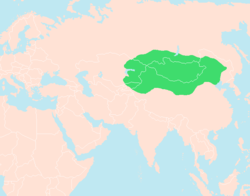Zhizhi Chanyu
| Zhizhi | |
|---|---|
| Chanyu | |
 Domain and influence of the Xiongnu | |
| Reign | c. 55–36 BCE |
| Predecessor | Several claimants |
| Successor | None |
| Dynasty | Maodun |
| Father | Xuluquanqu Chanyu |
Zhizhi Chanyu (郅支單於?,[1] died 36 BC) was a Chanyu of the Xiongnu at the time of the first Xiongnu civil war, who held the north and west in contention with his younger brother Huhanye who held the south. His original name in Chinese transcription was Luanti Hutuwusi (攣鞮呼屠吾斯),[2] i.e. one of the Worthy Princes of the East (of the Luandi clan).
When the 12th Chanyu died in 60 BC power was seized by a distant relative. In 58 BC, Huhanye, a younger son of the 12th Chanyu, revolted and made himself the 14th Chanyu.
In 56 BC Zhizhi, an elder brother of Huhanye, revolted, called himself Chanyu, and drove Huhanye out of the royal domain. As Zhizhi grew more powerful, Huhanye moved south and submitted to the Chinese (53 BC). Huhanye then used Chinese support to strengthen himself against his elder brother. Zhizhi tried to offer tribute to the Chinese and sent his son as hostage, but the Han dynasty favored Huhanye. Growing weaker, in 49 BC Zhizhi began moving west in the hope of reconstituting his empire. In the same year, Yilimu, a brother of the 13th Chanyu, declared himself Chanyu and was killed by Zhizhi. He successfully fought the Wusun, gained control of the Dingling and made his capital in the lands of the Jiankun who may have been the Yenisei Kirghiz (these last two are on the southern edge of Siberia).
In 44 BC he was reported to be on the north slope of the Tianshan in modern Xinjiang. The Han court returned his hostage son. For unknown reasons, Zhizhi murdered the envoy who accompanied his son. He made a marriage alliance with the rulers of Kangju near Lake Balkhash and led his entire tribe westward. They suffered greatly from cold and only 3,000 people reached Kangju (it is not clear if this was the whole population or counts only fighting men).
In alliance with the Kangju he plundered the Wusun. Later he quarreled with the Kangju, killed several hundred of them and forced the Kangju people to build him a fortress on the Dulaishui River (possibly the Ili River or the Talas River). It is not clear why Zhizhi would want a fortress since the great advantage of the Xiongnu was their mobile cavalry. The Chinese commander of the Western Regions began to fear that Zhizhi was planning to build a large empire and launched a preemptive attack. 40,000 Han troops marched on both sides of the Tarim Basin and moved toward Lake Balkhash. A Kangju raiding party which was returning from the Wusun attacked the Chinese rear and was later defeated by a Chinese counterattack. The Chinese burned Zhizhi's fort and killed him (Battle of Zhizhi, 36 BC).
See also
References
- ↑
- traditional Chinese: 郅支單於; simplified Chinese: 郅支單于; pinyin: Zhìzhī Chányú; Wade–Giles: Chih4-chih1 Ch'an2-yü2
- Russian: Shan'yuy Chzhichzhi (Шаньюй Чжичжи) or Chzhichzhi-khan (Чжичжи-хан)
- ↑ simplified Chinese: 挛鞮呼屠吾斯; traditional Chinese: 攣鞮呼屠吾斯; pinyin: Luándī Hūtúwúsī; Wade–Giles: Luan2-ti1 Hu1-t'u2-wu2-szu1
- Yap, Joseph P. (2009). Wars With The Xiongnu, A Translation from Zizhi tongjian. AuthorHouse, Bloomington, Indiana, U.S.A. ISBN 978-1-4490-0604-4, Chapters 10-12.